Legal, Ethical, and Professional Conduct: A Nursing Perspective
VerifiedAdded on 2023/02/01
|9
|2226
|27
Report
AI Summary
This report examines a nursing scenario involving a registered nurse (Ning) and a 16-year-old patient (Sabrina) in Queensland. Sabrina, considered Gillick competent, seeks advice from Ning regarding pregnancy symptoms and reveals a history of child abuse. The report delves into the legal, ethical, and professional issues arising from this case, focusing on autonomy, beneficence, non-maleficence, and justice. It explores the ethical implications of confidentiality versus mandatory reporting, particularly concerning Sabrina's right to make decisions about her reproductive health and the nurse's duty to protect a minor from abuse. The analysis considers relevant legislation, including the Child Protection Act 1999, and the Code of Professional Conduct and Ethics for nurses. The report concludes by emphasizing the importance of balancing patient care with legal and ethical obligations, advocating for mandatory reporting in cases of suspected child abuse to ensure patient safety and uphold professional standards. The document emphasizes that failing to report the abuse might be considered negligence and may result in disciplinary actions against the nurse.
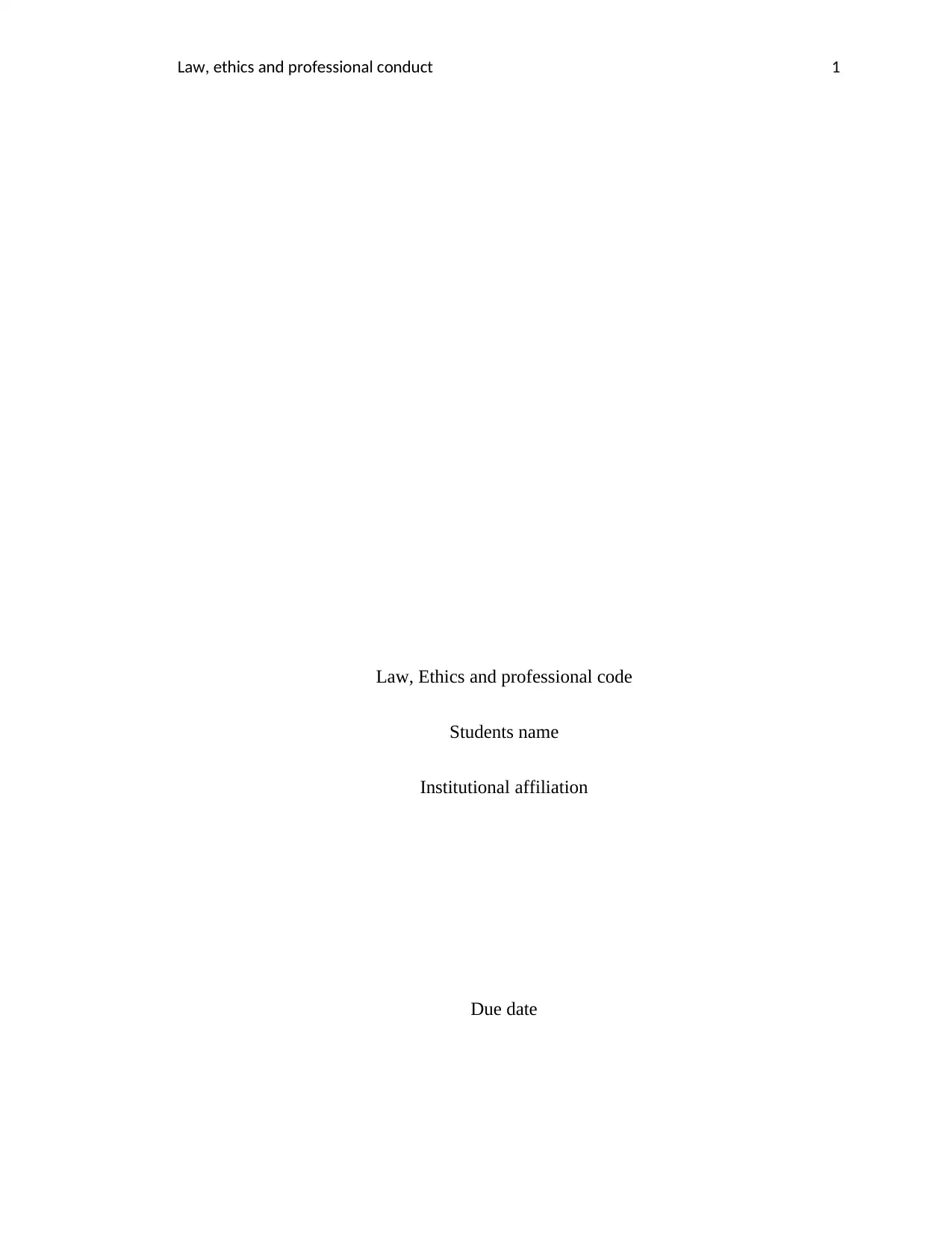
Law, ethics and professional conduct 1
Law, Ethics and professional code
Students name
Institutional affiliation
Due date
Law, Ethics and professional code
Students name
Institutional affiliation
Due date
Paraphrase This Document
Need a fresh take? Get an instant paraphrase of this document with our AI Paraphraser
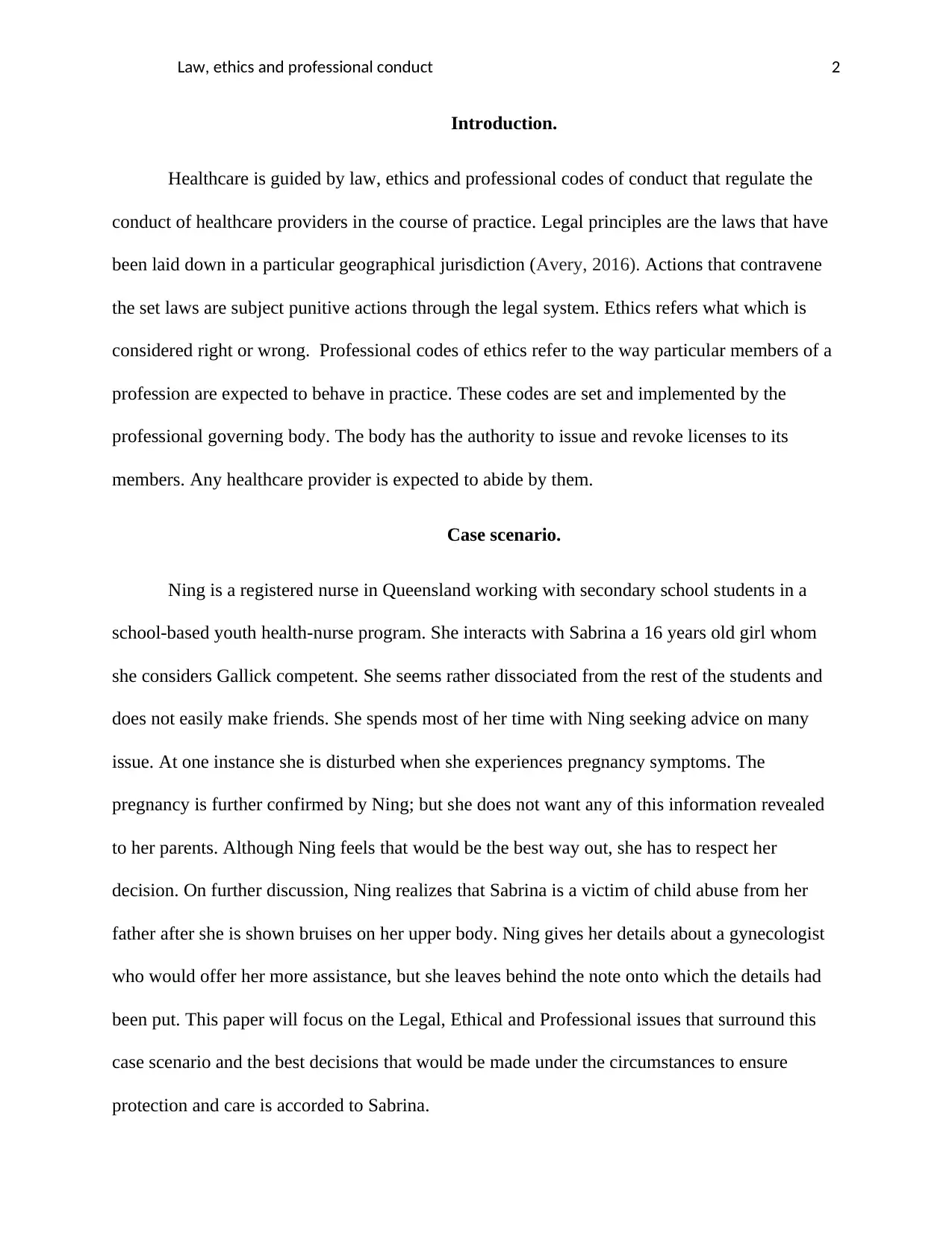
Law, ethics and professional conduct 2
Introduction.
Healthcare is guided by law, ethics and professional codes of conduct that regulate the
conduct of healthcare providers in the course of practice. Legal principles are the laws that have
been laid down in a particular geographical jurisdiction (Avery, 2016). Actions that contravene
the set laws are subject punitive actions through the legal system. Ethics refers what which is
considered right or wrong. Professional codes of ethics refer to the way particular members of a
profession are expected to behave in practice. These codes are set and implemented by the
professional governing body. The body has the authority to issue and revoke licenses to its
members. Any healthcare provider is expected to abide by them.
Case scenario.
Ning is a registered nurse in Queensland working with secondary school students in a
school-based youth health-nurse program. She interacts with Sabrina a 16 years old girl whom
she considers Gallick competent. She seems rather dissociated from the rest of the students and
does not easily make friends. She spends most of her time with Ning seeking advice on many
issue. At one instance she is disturbed when she experiences pregnancy symptoms. The
pregnancy is further confirmed by Ning; but she does not want any of this information revealed
to her parents. Although Ning feels that would be the best way out, she has to respect her
decision. On further discussion, Ning realizes that Sabrina is a victim of child abuse from her
father after she is shown bruises on her upper body. Ning gives her details about a gynecologist
who would offer her more assistance, but she leaves behind the note onto which the details had
been put. This paper will focus on the Legal, Ethical and Professional issues that surround this
case scenario and the best decisions that would be made under the circumstances to ensure
protection and care is accorded to Sabrina.
Introduction.
Healthcare is guided by law, ethics and professional codes of conduct that regulate the
conduct of healthcare providers in the course of practice. Legal principles are the laws that have
been laid down in a particular geographical jurisdiction (Avery, 2016). Actions that contravene
the set laws are subject punitive actions through the legal system. Ethics refers what which is
considered right or wrong. Professional codes of ethics refer to the way particular members of a
profession are expected to behave in practice. These codes are set and implemented by the
professional governing body. The body has the authority to issue and revoke licenses to its
members. Any healthcare provider is expected to abide by them.
Case scenario.
Ning is a registered nurse in Queensland working with secondary school students in a
school-based youth health-nurse program. She interacts with Sabrina a 16 years old girl whom
she considers Gallick competent. She seems rather dissociated from the rest of the students and
does not easily make friends. She spends most of her time with Ning seeking advice on many
issue. At one instance she is disturbed when she experiences pregnancy symptoms. The
pregnancy is further confirmed by Ning; but she does not want any of this information revealed
to her parents. Although Ning feels that would be the best way out, she has to respect her
decision. On further discussion, Ning realizes that Sabrina is a victim of child abuse from her
father after she is shown bruises on her upper body. Ning gives her details about a gynecologist
who would offer her more assistance, but she leaves behind the note onto which the details had
been put. This paper will focus on the Legal, Ethical and Professional issues that surround this
case scenario and the best decisions that would be made under the circumstances to ensure
protection and care is accorded to Sabrina.
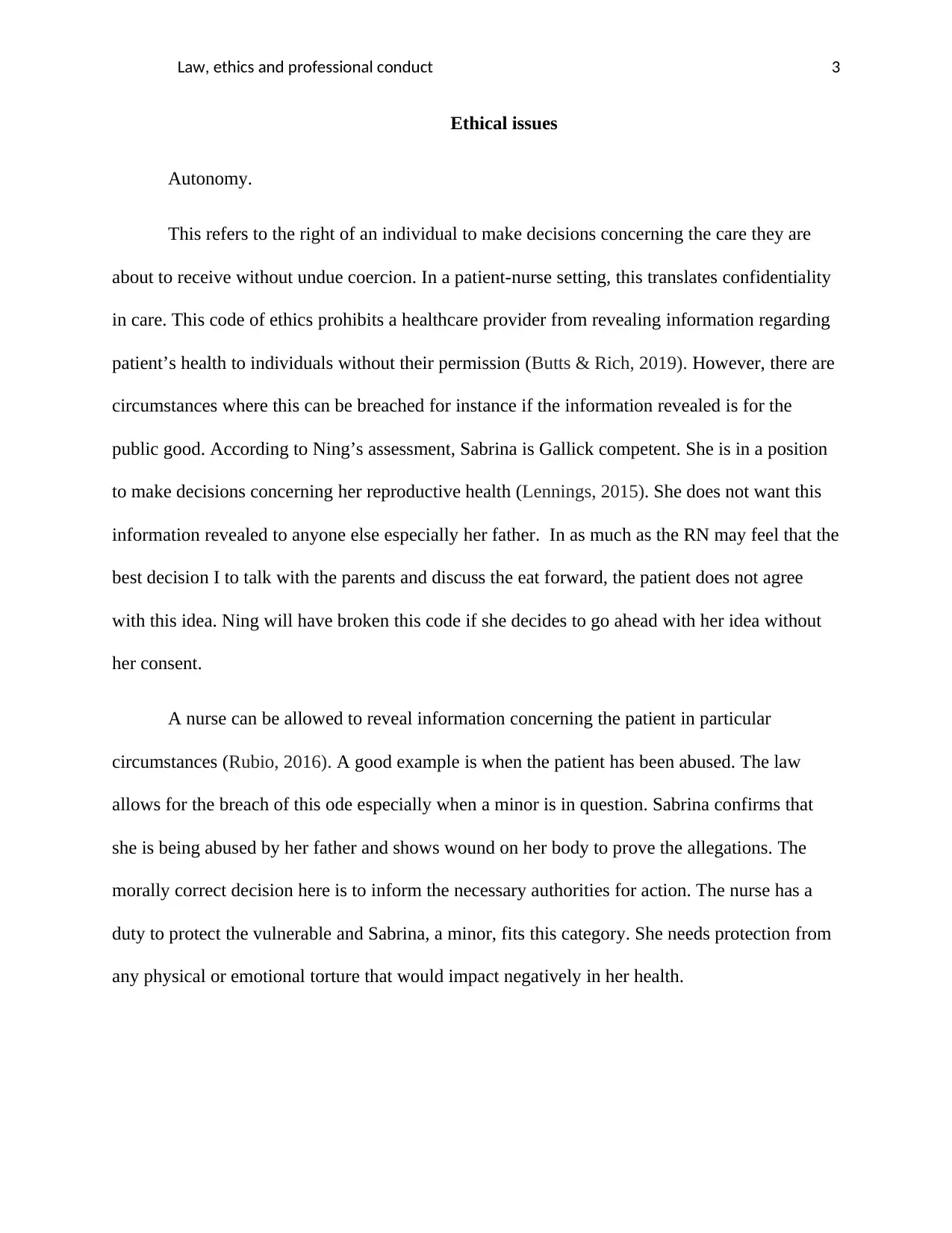
Law, ethics and professional conduct 3
Ethical issues
Autonomy.
This refers to the right of an individual to make decisions concerning the care they are
about to receive without undue coercion. In a patient-nurse setting, this translates confidentiality
in care. This code of ethics prohibits a healthcare provider from revealing information regarding
patient’s health to individuals without their permission (Butts & Rich, 2019). However, there are
circumstances where this can be breached for instance if the information revealed is for the
public good. According to Ning’s assessment, Sabrina is Gallick competent. She is in a position
to make decisions concerning her reproductive health (Lennings, 2015). She does not want this
information revealed to anyone else especially her father. In as much as the RN may feel that the
best decision I to talk with the parents and discuss the eat forward, the patient does not agree
with this idea. Ning will have broken this code if she decides to go ahead with her idea without
her consent.
A nurse can be allowed to reveal information concerning the patient in particular
circumstances (Rubio, 2016). A good example is when the patient has been abused. The law
allows for the breach of this ode especially when a minor is in question. Sabrina confirms that
she is being abused by her father and shows wound on her body to prove the allegations. The
morally correct decision here is to inform the necessary authorities for action. The nurse has a
duty to protect the vulnerable and Sabrina, a minor, fits this category. She needs protection from
any physical or emotional torture that would impact negatively in her health.
Ethical issues
Autonomy.
This refers to the right of an individual to make decisions concerning the care they are
about to receive without undue coercion. In a patient-nurse setting, this translates confidentiality
in care. This code of ethics prohibits a healthcare provider from revealing information regarding
patient’s health to individuals without their permission (Butts & Rich, 2019). However, there are
circumstances where this can be breached for instance if the information revealed is for the
public good. According to Ning’s assessment, Sabrina is Gallick competent. She is in a position
to make decisions concerning her reproductive health (Lennings, 2015). She does not want this
information revealed to anyone else especially her father. In as much as the RN may feel that the
best decision I to talk with the parents and discuss the eat forward, the patient does not agree
with this idea. Ning will have broken this code if she decides to go ahead with her idea without
her consent.
A nurse can be allowed to reveal information concerning the patient in particular
circumstances (Rubio, 2016). A good example is when the patient has been abused. The law
allows for the breach of this ode especially when a minor is in question. Sabrina confirms that
she is being abused by her father and shows wound on her body to prove the allegations. The
morally correct decision here is to inform the necessary authorities for action. The nurse has a
duty to protect the vulnerable and Sabrina, a minor, fits this category. She needs protection from
any physical or emotional torture that would impact negatively in her health.
⊘ This is a preview!⊘
Do you want full access?
Subscribe today to unlock all pages.

Trusted by 1+ million students worldwide
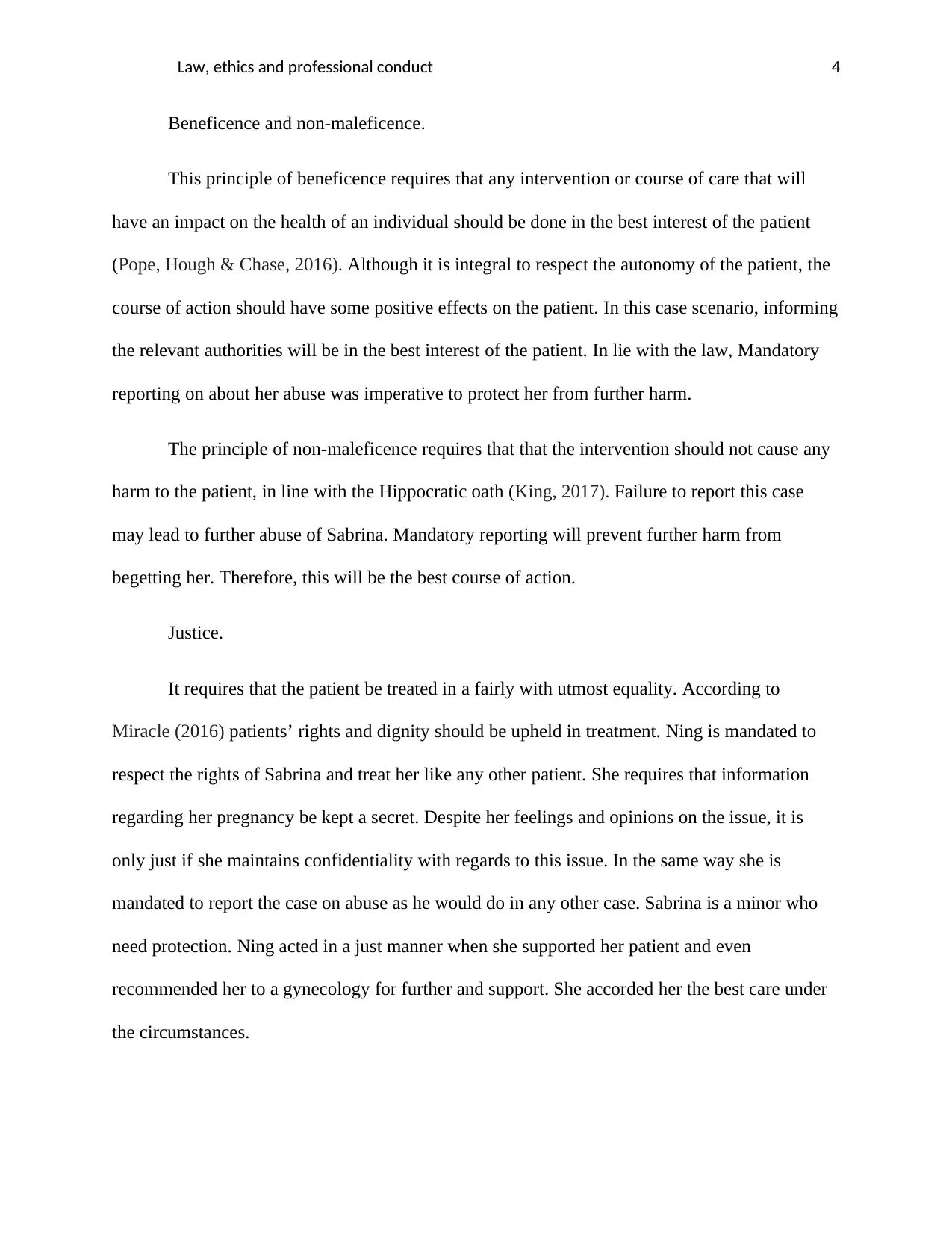
Law, ethics and professional conduct 4
Beneficence and non-maleficence.
This principle of beneficence requires that any intervention or course of care that will
have an impact on the health of an individual should be done in the best interest of the patient
(Pope, Hough & Chase, 2016). Although it is integral to respect the autonomy of the patient, the
course of action should have some positive effects on the patient. In this case scenario, informing
the relevant authorities will be in the best interest of the patient. In lie with the law, Mandatory
reporting on about her abuse was imperative to protect her from further harm.
The principle of non-maleficence requires that that the intervention should not cause any
harm to the patient, in line with the Hippocratic oath (King, 2017). Failure to report this case
may lead to further abuse of Sabrina. Mandatory reporting will prevent further harm from
begetting her. Therefore, this will be the best course of action.
Justice.
It requires that the patient be treated in a fairly with utmost equality. According to
Miracle (2016) patients’ rights and dignity should be upheld in treatment. Ning is mandated to
respect the rights of Sabrina and treat her like any other patient. She requires that information
regarding her pregnancy be kept a secret. Despite her feelings and opinions on the issue, it is
only just if she maintains confidentiality with regards to this issue. In the same way she is
mandated to report the case on abuse as he would do in any other case. Sabrina is a minor who
need protection. Ning acted in a just manner when she supported her patient and even
recommended her to a gynecology for further and support. She accorded her the best care under
the circumstances.
Beneficence and non-maleficence.
This principle of beneficence requires that any intervention or course of care that will
have an impact on the health of an individual should be done in the best interest of the patient
(Pope, Hough & Chase, 2016). Although it is integral to respect the autonomy of the patient, the
course of action should have some positive effects on the patient. In this case scenario, informing
the relevant authorities will be in the best interest of the patient. In lie with the law, Mandatory
reporting on about her abuse was imperative to protect her from further harm.
The principle of non-maleficence requires that that the intervention should not cause any
harm to the patient, in line with the Hippocratic oath (King, 2017). Failure to report this case
may lead to further abuse of Sabrina. Mandatory reporting will prevent further harm from
begetting her. Therefore, this will be the best course of action.
Justice.
It requires that the patient be treated in a fairly with utmost equality. According to
Miracle (2016) patients’ rights and dignity should be upheld in treatment. Ning is mandated to
respect the rights of Sabrina and treat her like any other patient. She requires that information
regarding her pregnancy be kept a secret. Despite her feelings and opinions on the issue, it is
only just if she maintains confidentiality with regards to this issue. In the same way she is
mandated to report the case on abuse as he would do in any other case. Sabrina is a minor who
need protection. Ning acted in a just manner when she supported her patient and even
recommended her to a gynecology for further and support. She accorded her the best care under
the circumstances.
Paraphrase This Document
Need a fresh take? Get an instant paraphrase of this document with our AI Paraphraser
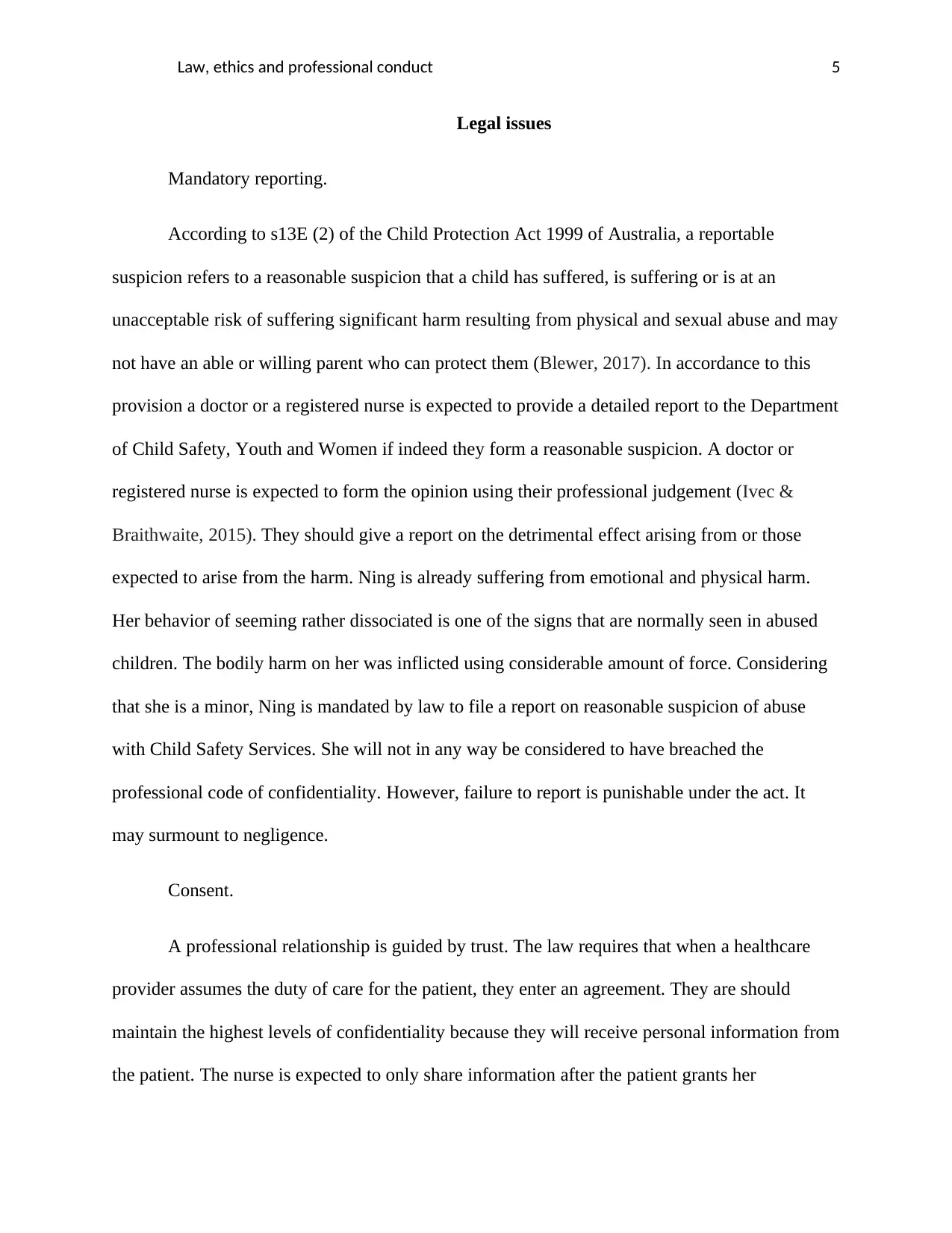
Law, ethics and professional conduct 5
Legal issues
Mandatory reporting.
According to s13E (2) of the Child Protection Act 1999 of Australia, a reportable
suspicion refers to a reasonable suspicion that a child has suffered, is suffering or is at an
unacceptable risk of suffering significant harm resulting from physical and sexual abuse and may
not have an able or willing parent who can protect them (Blewer, 2017). In accordance to this
provision a doctor or a registered nurse is expected to provide a detailed report to the Department
of Child Safety, Youth and Women if indeed they form a reasonable suspicion. A doctor or
registered nurse is expected to form the opinion using their professional judgement (Ivec &
Braithwaite, 2015). They should give a report on the detrimental effect arising from or those
expected to arise from the harm. Ning is already suffering from emotional and physical harm.
Her behavior of seeming rather dissociated is one of the signs that are normally seen in abused
children. The bodily harm on her was inflicted using considerable amount of force. Considering
that she is a minor, Ning is mandated by law to file a report on reasonable suspicion of abuse
with Child Safety Services. She will not in any way be considered to have breached the
professional code of confidentiality. However, failure to report is punishable under the act. It
may surmount to negligence.
Consent.
A professional relationship is guided by trust. The law requires that when a healthcare
provider assumes the duty of care for the patient, they enter an agreement. They are should
maintain the highest levels of confidentiality because they will receive personal information from
the patient. The nurse is expected to only share information after the patient grants her
Legal issues
Mandatory reporting.
According to s13E (2) of the Child Protection Act 1999 of Australia, a reportable
suspicion refers to a reasonable suspicion that a child has suffered, is suffering or is at an
unacceptable risk of suffering significant harm resulting from physical and sexual abuse and may
not have an able or willing parent who can protect them (Blewer, 2017). In accordance to this
provision a doctor or a registered nurse is expected to provide a detailed report to the Department
of Child Safety, Youth and Women if indeed they form a reasonable suspicion. A doctor or
registered nurse is expected to form the opinion using their professional judgement (Ivec &
Braithwaite, 2015). They should give a report on the detrimental effect arising from or those
expected to arise from the harm. Ning is already suffering from emotional and physical harm.
Her behavior of seeming rather dissociated is one of the signs that are normally seen in abused
children. The bodily harm on her was inflicted using considerable amount of force. Considering
that she is a minor, Ning is mandated by law to file a report on reasonable suspicion of abuse
with Child Safety Services. She will not in any way be considered to have breached the
professional code of confidentiality. However, failure to report is punishable under the act. It
may surmount to negligence.
Consent.
A professional relationship is guided by trust. The law requires that when a healthcare
provider assumes the duty of care for the patient, they enter an agreement. They are should
maintain the highest levels of confidentiality because they will receive personal information from
the patient. The nurse is expected to only share information after the patient grants her
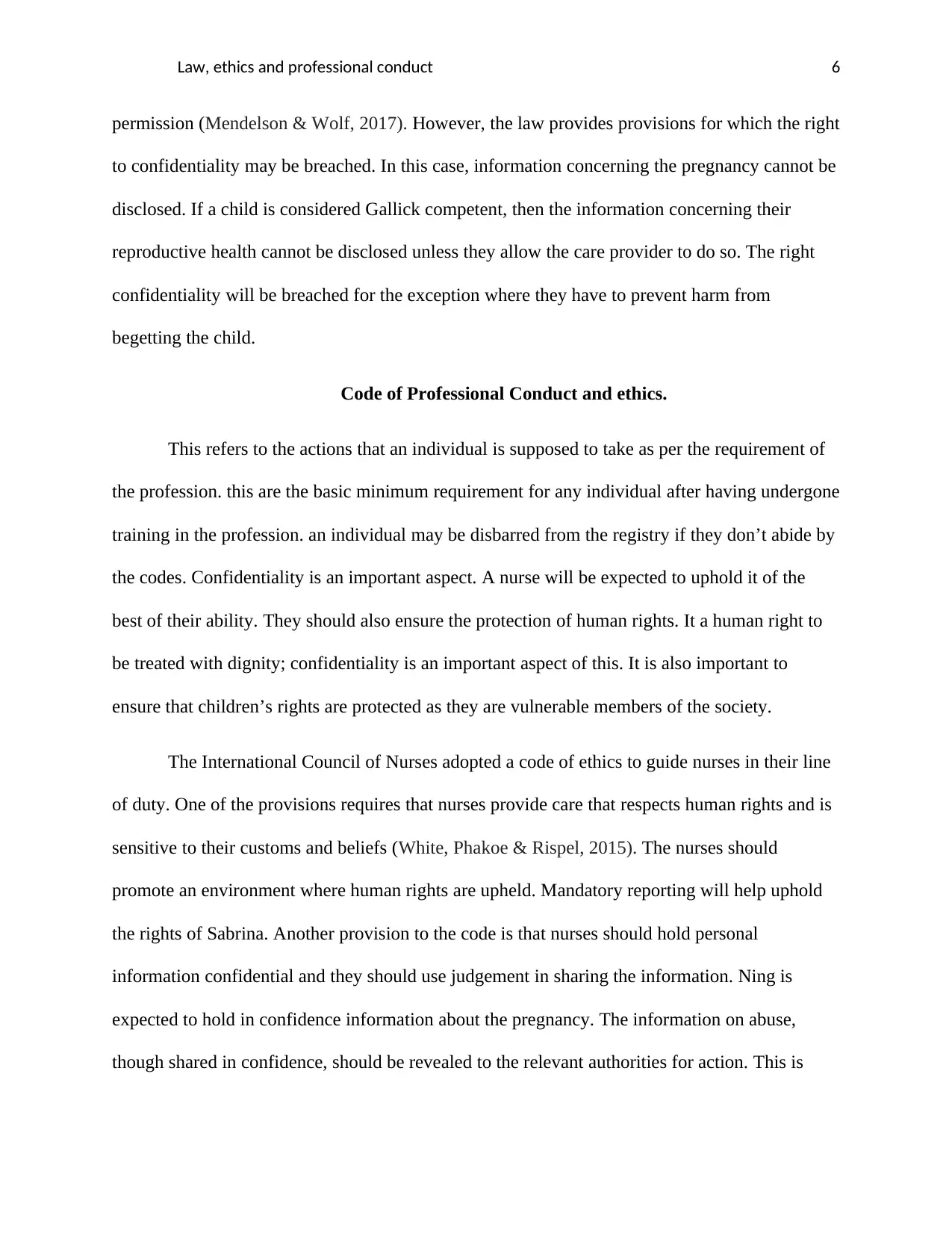
Law, ethics and professional conduct 6
permission (Mendelson & Wolf, 2017). However, the law provides provisions for which the right
to confidentiality may be breached. In this case, information concerning the pregnancy cannot be
disclosed. If a child is considered Gallick competent, then the information concerning their
reproductive health cannot be disclosed unless they allow the care provider to do so. The right
confidentiality will be breached for the exception where they have to prevent harm from
begetting the child.
Code of Professional Conduct and ethics.
This refers to the actions that an individual is supposed to take as per the requirement of
the profession. this are the basic minimum requirement for any individual after having undergone
training in the profession. an individual may be disbarred from the registry if they don’t abide by
the codes. Confidentiality is an important aspect. A nurse will be expected to uphold it of the
best of their ability. They should also ensure the protection of human rights. It a human right to
be treated with dignity; confidentiality is an important aspect of this. It is also important to
ensure that children’s rights are protected as they are vulnerable members of the society.
The International Council of Nurses adopted a code of ethics to guide nurses in their line
of duty. One of the provisions requires that nurses provide care that respects human rights and is
sensitive to their customs and beliefs (White, Phakoe & Rispel, 2015). The nurses should
promote an environment where human rights are upheld. Mandatory reporting will help uphold
the rights of Sabrina. Another provision to the code is that nurses should hold personal
information confidential and they should use judgement in sharing the information. Ning is
expected to hold in confidence information about the pregnancy. The information on abuse,
though shared in confidence, should be revealed to the relevant authorities for action. This is
permission (Mendelson & Wolf, 2017). However, the law provides provisions for which the right
to confidentiality may be breached. In this case, information concerning the pregnancy cannot be
disclosed. If a child is considered Gallick competent, then the information concerning their
reproductive health cannot be disclosed unless they allow the care provider to do so. The right
confidentiality will be breached for the exception where they have to prevent harm from
begetting the child.
Code of Professional Conduct and ethics.
This refers to the actions that an individual is supposed to take as per the requirement of
the profession. this are the basic minimum requirement for any individual after having undergone
training in the profession. an individual may be disbarred from the registry if they don’t abide by
the codes. Confidentiality is an important aspect. A nurse will be expected to uphold it of the
best of their ability. They should also ensure the protection of human rights. It a human right to
be treated with dignity; confidentiality is an important aspect of this. It is also important to
ensure that children’s rights are protected as they are vulnerable members of the society.
The International Council of Nurses adopted a code of ethics to guide nurses in their line
of duty. One of the provisions requires that nurses provide care that respects human rights and is
sensitive to their customs and beliefs (White, Phakoe & Rispel, 2015). The nurses should
promote an environment where human rights are upheld. Mandatory reporting will help uphold
the rights of Sabrina. Another provision to the code is that nurses should hold personal
information confidential and they should use judgement in sharing the information. Ning is
expected to hold in confidence information about the pregnancy. The information on abuse,
though shared in confidence, should be revealed to the relevant authorities for action. This is
⊘ This is a preview!⊘
Do you want full access?
Subscribe today to unlock all pages.

Trusted by 1+ million students worldwide
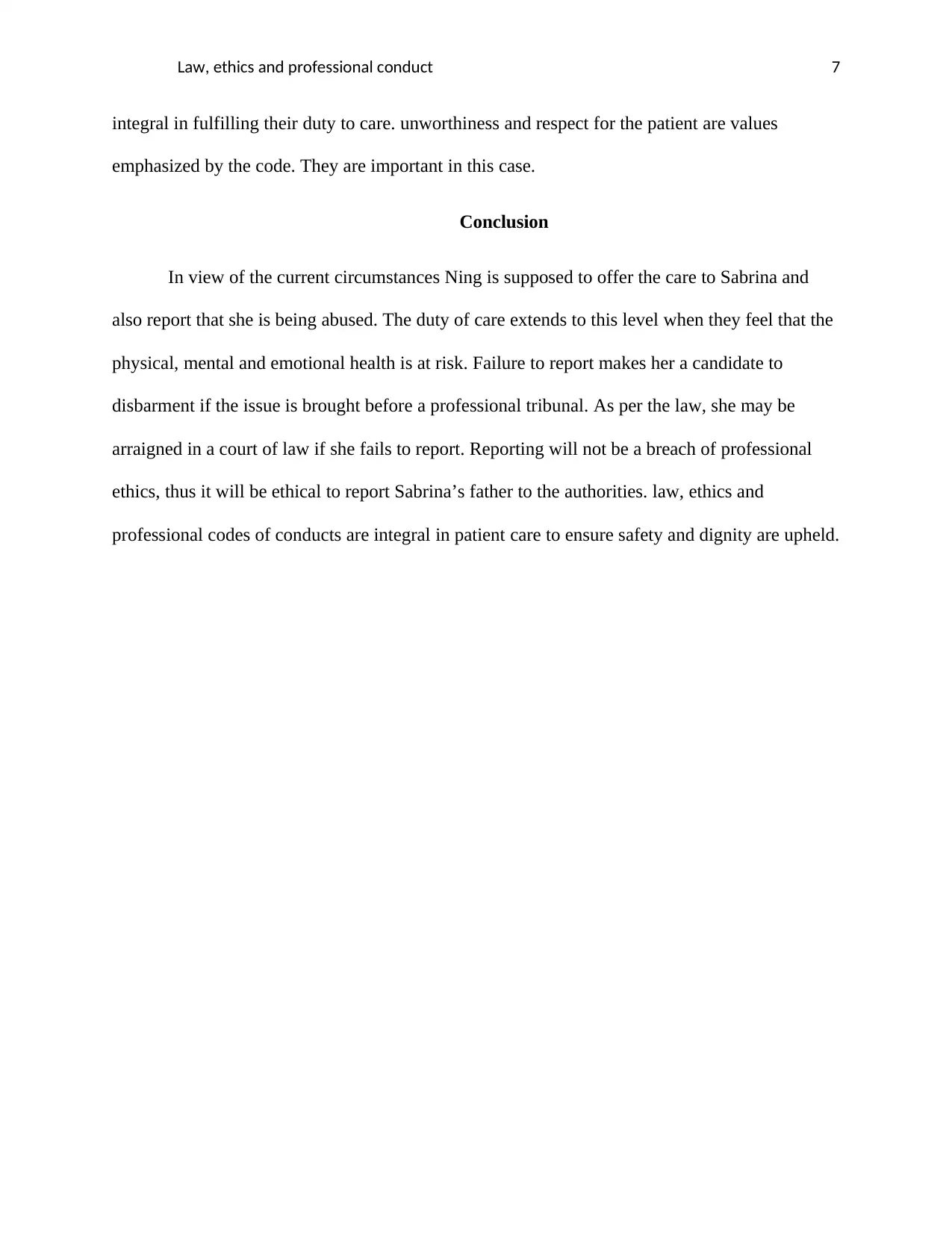
Law, ethics and professional conduct 7
integral in fulfilling their duty to care. unworthiness and respect for the patient are values
emphasized by the code. They are important in this case.
Conclusion
In view of the current circumstances Ning is supposed to offer the care to Sabrina and
also report that she is being abused. The duty of care extends to this level when they feel that the
physical, mental and emotional health is at risk. Failure to report makes her a candidate to
disbarment if the issue is brought before a professional tribunal. As per the law, she may be
arraigned in a court of law if she fails to report. Reporting will not be a breach of professional
ethics, thus it will be ethical to report Sabrina’s father to the authorities. law, ethics and
professional codes of conducts are integral in patient care to ensure safety and dignity are upheld.
integral in fulfilling their duty to care. unworthiness and respect for the patient are values
emphasized by the code. They are important in this case.
Conclusion
In view of the current circumstances Ning is supposed to offer the care to Sabrina and
also report that she is being abused. The duty of care extends to this level when they feel that the
physical, mental and emotional health is at risk. Failure to report makes her a candidate to
disbarment if the issue is brought before a professional tribunal. As per the law, she may be
arraigned in a court of law if she fails to report. Reporting will not be a breach of professional
ethics, thus it will be ethical to report Sabrina’s father to the authorities. law, ethics and
professional codes of conducts are integral in patient care to ensure safety and dignity are upheld.
Paraphrase This Document
Need a fresh take? Get an instant paraphrase of this document with our AI Paraphraser
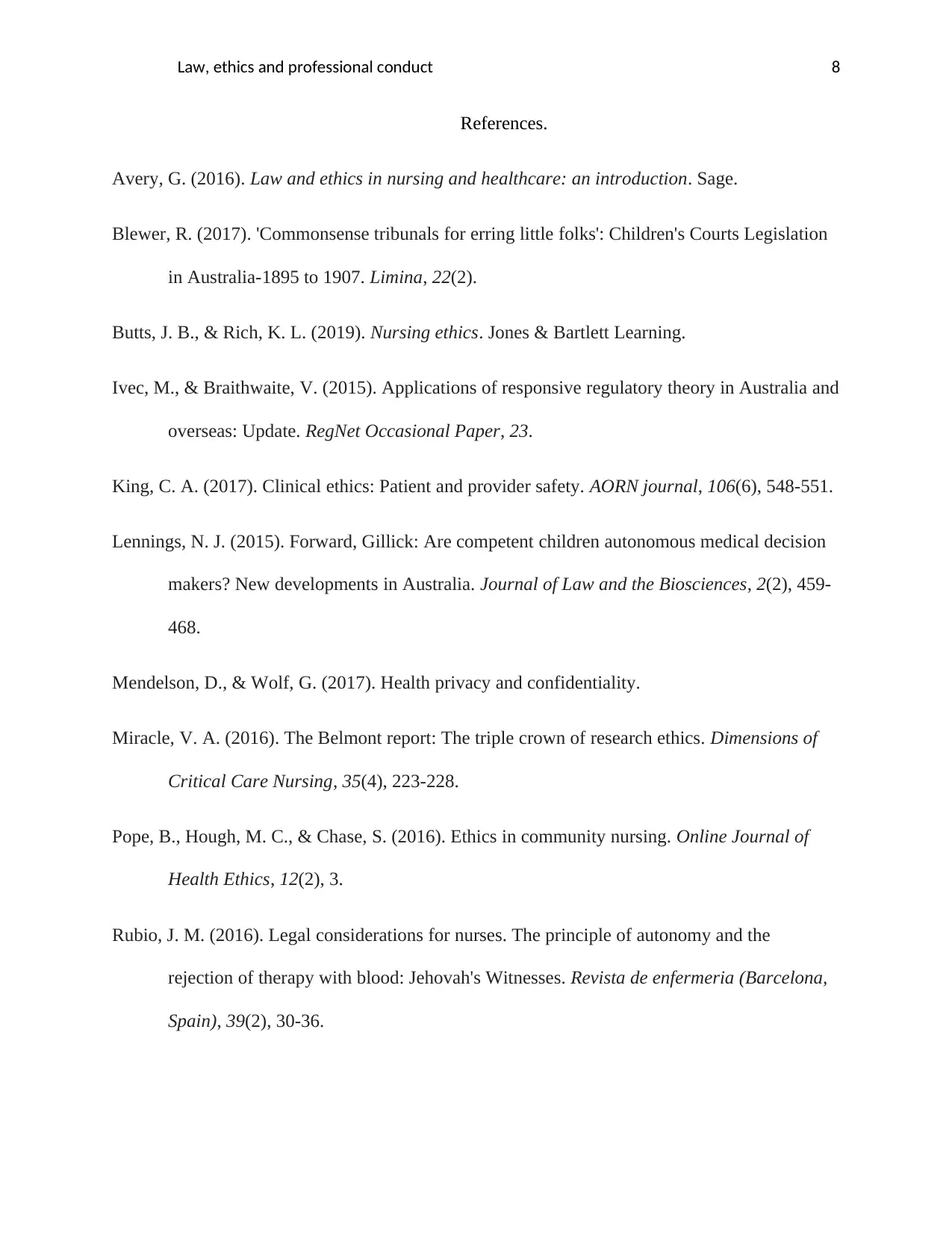
Law, ethics and professional conduct 8
References.
Avery, G. (2016). Law and ethics in nursing and healthcare: an introduction. Sage.
Blewer, R. (2017). 'Commonsense tribunals for erring little folks': Children's Courts Legislation
in Australia-1895 to 1907. Limina, 22(2).
Butts, J. B., & Rich, K. L. (2019). Nursing ethics. Jones & Bartlett Learning.
Ivec, M., & Braithwaite, V. (2015). Applications of responsive regulatory theory in Australia and
overseas: Update. RegNet Occasional Paper, 23.
King, C. A. (2017). Clinical ethics: Patient and provider safety. AORN journal, 106(6), 548-551.
Lennings, N. J. (2015). Forward, Gillick: Are competent children autonomous medical decision
makers? New developments in Australia. Journal of Law and the Biosciences, 2(2), 459-
468.
Mendelson, D., & Wolf, G. (2017). Health privacy and confidentiality.
Miracle, V. A. (2016). The Belmont report: The triple crown of research ethics. Dimensions of
Critical Care Nursing, 35(4), 223-228.
Pope, B., Hough, M. C., & Chase, S. (2016). Ethics in community nursing. Online Journal of
Health Ethics, 12(2), 3.
Rubio, J. M. (2016). Legal considerations for nurses. The principle of autonomy and the
rejection of therapy with blood: Jehovah's Witnesses. Revista de enfermeria (Barcelona,
Spain), 39(2), 30-36.
References.
Avery, G. (2016). Law and ethics in nursing and healthcare: an introduction. Sage.
Blewer, R. (2017). 'Commonsense tribunals for erring little folks': Children's Courts Legislation
in Australia-1895 to 1907. Limina, 22(2).
Butts, J. B., & Rich, K. L. (2019). Nursing ethics. Jones & Bartlett Learning.
Ivec, M., & Braithwaite, V. (2015). Applications of responsive regulatory theory in Australia and
overseas: Update. RegNet Occasional Paper, 23.
King, C. A. (2017). Clinical ethics: Patient and provider safety. AORN journal, 106(6), 548-551.
Lennings, N. J. (2015). Forward, Gillick: Are competent children autonomous medical decision
makers? New developments in Australia. Journal of Law and the Biosciences, 2(2), 459-
468.
Mendelson, D., & Wolf, G. (2017). Health privacy and confidentiality.
Miracle, V. A. (2016). The Belmont report: The triple crown of research ethics. Dimensions of
Critical Care Nursing, 35(4), 223-228.
Pope, B., Hough, M. C., & Chase, S. (2016). Ethics in community nursing. Online Journal of
Health Ethics, 12(2), 3.
Rubio, J. M. (2016). Legal considerations for nurses. The principle of autonomy and the
rejection of therapy with blood: Jehovah's Witnesses. Revista de enfermeria (Barcelona,
Spain), 39(2), 30-36.
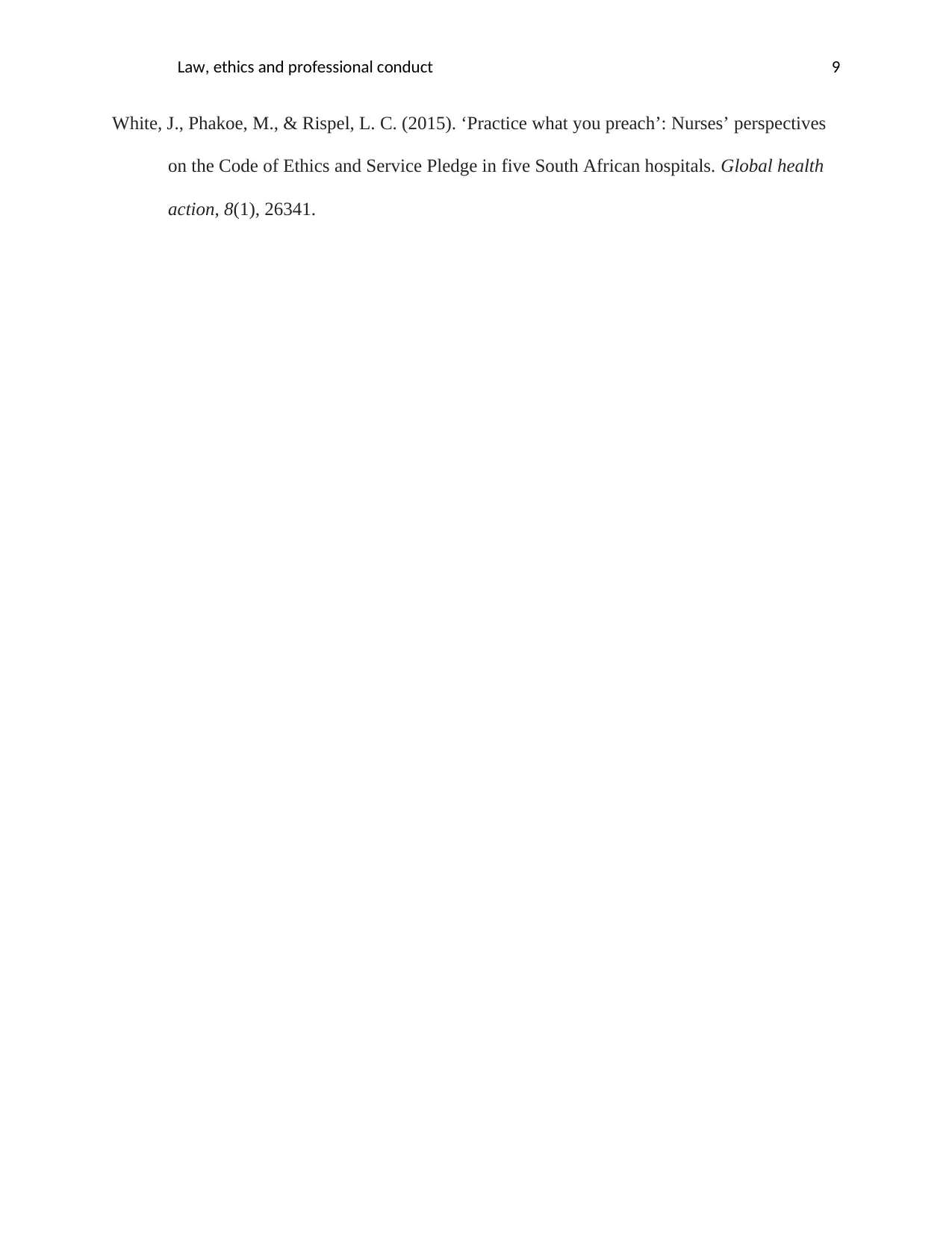
Law, ethics and professional conduct 9
White, J., Phakoe, M., & Rispel, L. C. (2015). ‘Practice what you preach’: Nurses’ perspectives
on the Code of Ethics and Service Pledge in five South African hospitals. Global health
action, 8(1), 26341.
White, J., Phakoe, M., & Rispel, L. C. (2015). ‘Practice what you preach’: Nurses’ perspectives
on the Code of Ethics and Service Pledge in five South African hospitals. Global health
action, 8(1), 26341.
⊘ This is a preview!⊘
Do you want full access?
Subscribe today to unlock all pages.

Trusted by 1+ million students worldwide
1 out of 9
Related Documents
Your All-in-One AI-Powered Toolkit for Academic Success.
+13062052269
info@desklib.com
Available 24*7 on WhatsApp / Email
![[object Object]](/_next/static/media/star-bottom.7253800d.svg)
Unlock your academic potential
Copyright © 2020–2025 A2Z Services. All Rights Reserved. Developed and managed by ZUCOL.





